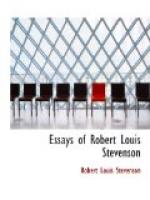[Note 9: Consuelo, Clarissa Harlowe, Vautrin, Steenie Steenson. Consuelo is the title of one of the most notable novels by the famous French authoress, George Sand, (1804-1876), whose real name was Aurore Dupin. Consuelo appeared in 1842.... Clarissa (1747-8) was the masterpiece of the novelist Samuel Richardson (1689-1761). This great novel, in seven fat volumes, was a warm favorite with Stevenson, as it has been with most English writers from Dr. Johnson to Macaulay. Writing to a friend in December 1877, Stevenson said, “Please, if you have not, and I don’t suppose you have, already read it, institute a search in all Melbourne for one of the rarest and certainly one of the best of books—Clarissa Harlowe. For any man who takes an interest in the problems of the two sexes, that book is a perfect mine of documents. And it is written, sir, with the pen of an angel.” (Letters, I, 141.) Editions of Clarissa are not so scarce now as they were thirty years ago; several have appeared within the last few years.... Vautrin is one of the most remarkable characters in several novels of Balzac; see especially Pere Goriot (1834) ... Steenie Steenson in Scott’s novel Redgauntlet (1824).]
[Note 10: No human being, etc. Stevenson loved action in novels, and was impatient, as many readers are, when long-drawn descriptions of scenery were introduced. Furthermore, the love for wild scenery has become as fashionable as the love for music; the result being a very general hypocrisy in assumed ecstatic raptures.]
[Note 11: You can keep no men long, nor Scotchmen at all. Every Scotchman is a born theologian. Franklin says in his Autobiography, “I had caught this by reading my father’s books of dispute on Religion. Persons of good sense, I have since observed seldom fall into it, except lawyers, university men, and generally men of all sorts who have been bred at Edinburgh.” (Chap. I.)]
[Note 12: A court of love. A mediaeval institution of chivalry, where questions of knight-errantry, constancy in love, etc., were discussed and for the time being, decided.]
[Note 13: Spring-Heel’d Jack. This is Stevenson’s cousin “Bob,” Robert Alan Mowbray Stevenson (1847-1900), an artist and later Professor of Fine Arts at University College, Liverpool. He was one of the best conversationalists in England. Stevenson said of him,
“My cousin Bob, ... is the man likest and most unlike to me that I have ever met.... What was specially his, and genuine, was his faculty for turning over a subject in conversation. There was an insane lucidity in his conclusions; a singular, humorous eloquence in his language, and a power of method, bringing the whole of life into the focus of the subject under hand; none of which I have ever heard equalled or even approached by any other talker.” (Balfour’s Life of Stevenson, I, 103.




